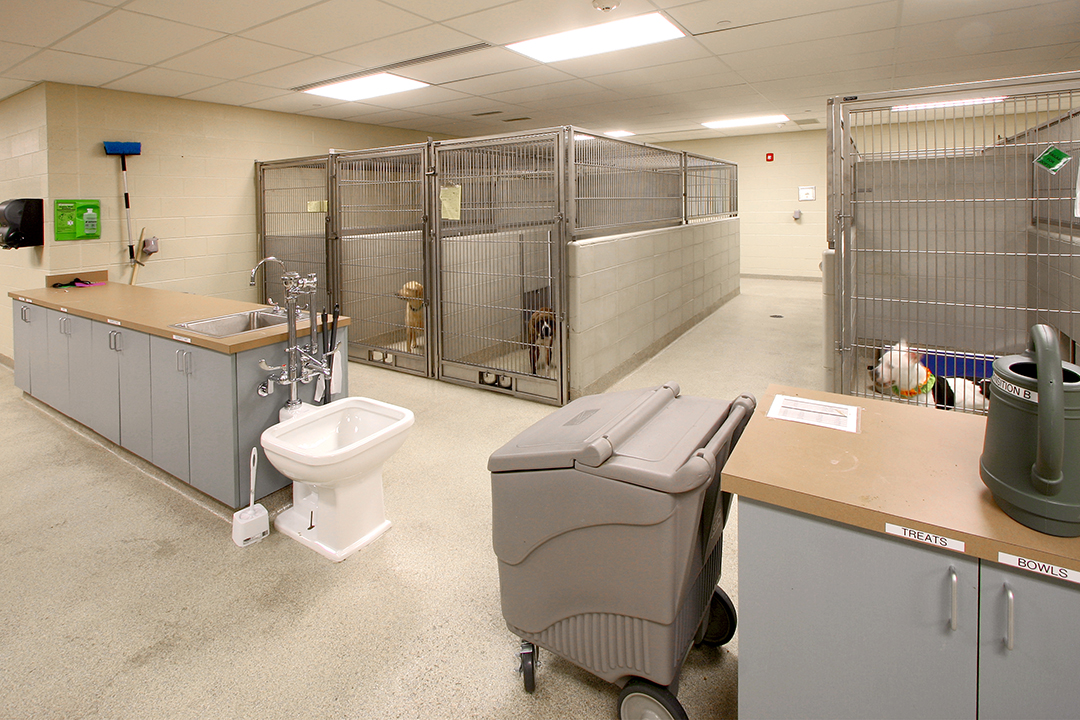Can You Build Shelter/Adoption Centers for the Same Cost as Private Boarding Facilities?

GuernseyTingle has designed numerous private animal boarding facilities, in addition to our public and non-profit shelter work. We have also designed many private veterinary clinics, animal hospitals and specialty animal care facilities.
The question often comes up in our public work, “Why does a public shelter/adoption facility cost more to build than a private animal boarding facility?” The answers are numerous, but the primary differences in the facilities can be summarized as follows:
Animal Behavior
Private boarding facilities house our pets, and the vast majority of the dogs have been trained and are somewhat socialized around other animals and animal care providers. Public shelters house animal control pickups, strays, surrenders, court holding and other animals with unknown – and often aggressive – behaviors. This requires more care in the design of all finishes and systems, especially in the dog runs and animal holding areas. We often use materials such as fiberglass and pre-manufactured runs in private boarding facilities. Public shelters typically need much more durable and more expensive glazed block, CMU and epoxy finishes. If a private boarder has an aggressive dog that chews through the wall of a run (we’ve had it happen!), he or she can refuse to board the animal. A public shelter does not have that option.
Water and Airborne Diseases
Because of the known source of their boarded animals, private boarding facilities rarely have serious disease outbreaks other than Bordetella (kennel cough) and other minor diseases. Public shelters are highly susceptible to ringworm, fungal outbreaks and canine parvovirus. Control of these contagious diseases requires more expensive and robust HVAC systems, higher air circulation, more frequent air turnover, better filtration and better sanitary sewer systems. A parvo outbreak in a public shelter can be fatal to many animals, and can require complete evacuation and closure for a period of time.
Segregation of Support Services
Private boarding facilities will typically have separate dog boarding areas in order to house like animals, like personalities or like characteristics. One laundry area, feeding area and storage area can support many or all of the boarding spaces. In a public shelter, further separation is needed for quarantine, isolation, court holding, behavior evaluation and adoption-ready animals. In order to minimize cross-contamination, multiple laundry, feeding and support areas must be designed in the adoption facility.
Staffing
Most private boarding facilities have paid, trained staff to care for and exercise the animals, and clean and sanitize the facilities. Public shelters often supplement minimal paid staff with volunteers, inmate workforce and other untrained or lightly trained staff. In addition, there is often high turnover in these staffs, and volunteers that may only work a few hours a week or a month. The finishes, cleaning systems, feeding systems, waste removal systems, etc. in adoption facilities need to be “volunteer friendly” to allow non-trained persons to effectively care for the animals and the facility.
Private vs. Public Investment
Many of our private boarding clients recognize that their facilities must meet minimum code standards, while satisfying financing requirements such as appraisals and amortization periods. Most of those facilities are designed to 20-30 year standards, at which time the original owner has achieved his/her investment and/or career expectations, and the facility is renovated, repurposed or replaced. Our public and non-profit clients are more often looking for facilities that last for 50+ years, and expect the materials and systems to support that investment without major overhauls.
There are many more detailed differences between private boarding facilities and public shelters. Please contact us with questions as you plan your animal care facilities.
